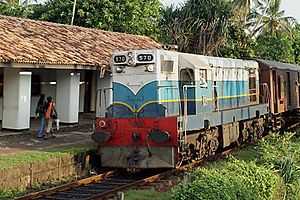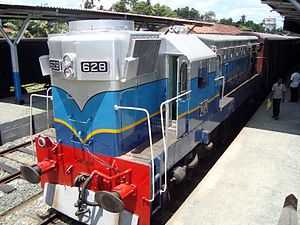EMD G12
| EMD G12 series | |
|---|---|
 Class M2 570 - "ALBERTA" in Sri Lanka | |
| Specifications | |
| Power type | Diesel-electric |
| Builder |
General Motors Electro-Motive Division (USA), General Motors Diesel (Canada) Clyde Engineering (Australia) |
| Model | G12 |
| Build date | 1950s |
| Total produced |
B-B version: 670 A1A-A1A version: 300 C-C version: 66 |
| AAR wheel arr. | A1A-A1A and B-B |
| Gauge |
1,000 mm (3 ft 3 3⁄8 in) 3 ft 6 in (1,067 mm) 4 ft 8 1⁄2 in (1,435 mm) 5 ft 3 in (1,600 mm) 5 ft 6 in (1,676 mm) |
| Locomotive weight | 107 long tons (109 t; 120 short tons) |
| Fuel capacity | 2,840 litres (750 US gal; 620 imp gal) |
| Prime mover | EMD 567 |
| Engine type | two-stroke diesel |
| Cylinders | V12 |
| Cylinder size | 8.5 in × 10 in (216 mm × 254 mm) |
| Transmission | Electric |
| Power output | 1,310 or 1,425 bhp (977 or 1,063 kW) |
| Tractive effort | 19,100 kgf (187.3 kN; 42,108.3 lbf) |
| Career | |
| Disposition | Most scrapped, many preserved, some still in service |
The EMD G12 was a class of locomotive built by GM-EMD, and its Canadian affiliate General Motors Diesel. In addition, Australian licensee Clyde Engineering built ten locomotives for New Zealand in 1957, five for Hong Kong, 23 for Queensland, 14 for Western Australia and seven for BHP. Australian licensee Commonwealth Engineering also built 42 for Queensland Rail in 1964–66. Many examples were built in the 1950-60s for railroads all over the world. They are powered by EMD 12-567C prime movers rated at 1,250 hp (930 kW). Some have been rebuilt with EMD 645 engines.
Original Owners
Bo-Bo version
Australia
- 7 Broken Hill Proprietary Company – DE class
Brazil
A total of 241 locomotives:
- 2 Estrada de Ferro de Goiás 5201–5202
- 30 Mogiana Railway 3001–3030
- 43 Estrada de Ferro Noroeste do Brasil 1101–1143
- 17 Rede de Viação Paraná-Santa Catarina
- 18 São Paulo Railway 700–717
- 25 Rede Mineira de Viação 2201–2207, 2217–2228
- 71 Viação Férrea do Rio Grande do Sul 2121–2145, 2161–2168, 6169–6206
- 35 Estrada de Ferro Vitória a Minas 531–565
Canada
- 2 London and Port Stanley Railway L4, L5
- 1 General Motors Diesel demonstrator 7707 (to Sweden as Statens Järnvägar T42)
Chile
- 3 Andes Copper Mining 81–83
Egypt
- 97 Egyptian Railways 3701–3797.[1] During the 1967 Six-Day War, Israel captured 4712, 3715, 3766 and 3795, which were appropriated to Israel Railways stock.
Israel
- 23 Israel Railways 104–126,[2] some since rebuilt with 12-645E engines. After the 1967 Six-Day War, four captured Egyptian G12s were renumbered 127–130.[3]
Iran
- 137 Islamic Republic of Iran Railways 40.01–40.137
Hong Kong
- 5 Kowloon-Canton Railway 51–55 (52–55 to Chicago Freight Car Leasing Australia as TL152–TL155)
Mexico
- 84 Ferrocarriles Nacionales de México 5806–5889
Netherlands
- 5 Dutch State Mines 151-155 (Built under license as Henschel G12 in Germany)
South Korea
- 47 Korean National Railways 4001–4015, 4101–4110, 4201–4222
Nigeria
- 25 Nigerian Railways 1101–1125
Norway
- 2 Sydvaranger 1, DE101 – G12 (used on the Kirkenes–Bjørnevatn Line, 1954–97)
Sri Lanka
Class M2C 626–627 (Only use for upcountry between Rathmalana, Colombo- Kandy, Badulla)
Venezuela
- Government Coal Mines 01–03
A1A-A1A version
Argentina
- 25 F.C.G.Sarmiento Railway 4501–4525
Australia
- 13 Queensland Rail 1400–1412–1400 class (remainder of order built as 1450 class; Co-Co)
Brazil
A total of 26 locomotives:
- 6 Rede Mineira de Viação 2708–2712
- 20 Viação Férrea do Rio Grande do Sul 2101–2120
Indonesia
- 11 Indonesian State Railways BB201 01–BB201 11
Mexico
- 6 Ferrocarriles Nacionales de México 5800–5805
New Zealand
- 146 New Zealand Government Railways 1400–1545 – New Zealand DA class locomotive
Sri Lanka

- 12 Sri Lanka Railways.[4] All except M2 571 still in daily operation (1). Classified as Class M2
- Class M2 569–573 One engine(M2 571)destroyed by terrorism.
- Class M2A 591–593
- Class M2B 594–595
- Class M2D 628–629
Taiwan
- 52 Taiwan Railway Administration R21–R72; some of their engines were replaced to 12-645E. R56–59: sent to Malawi Railways in July 2006.
USA
- 1 Electro-Motive Division demonstrator 1956
Co-Co version
Australia
A total of 66 locomotives:
- 10 Queensland Rail 1450–1459–1450 class (initial part of order built as 1400 class; A1A-A1A)
- 42 Queensland Rail 1460–1501–1460 class (later on-sold to Tranz Rail and converted to DQ class locomotives for use in New Zealand and Tasmania).
- 14 Western Australian Government Railways 1501–1514 – WAGR A class (diesel)
Gallery
-
Kowloon-Canton Railway 51, a G12 built by Clyde Engineering (serial number 55-59 of 1955), photographed in the Hong Kong Railway Museum, November 2005.
-

Kowloon-Canton Railway EMD G12, No.55 (R. D. Walker), at Tai Po Market Station, Hong Kong, June 2000.
-
Estrada de Ferro Vitória a Minas (EFVM) 531, a G12 built by EMD (serial number 21936 of 1956) photographed at Aimorés station, Aimorés, MG, Brasil, March 2008.
-

Taiwan Railway Administration R69 at Changhua Roundhouse.
-

An EMD G12 in Israel
-

Sri Lanka Railways Class M2 No 628 at Matara.
-

DQ 6324 at Palmerston North, New Zealand.
-

Preserved DA 1400 at Auckland's Museum of Transport and Technology.
See also
References
- ↑ Hughes, Hugh (1981). Middle East Railways. Harrow: Continental Railway Circle. p. 26. ISBN 0-9503469-7-7.
- ↑ Cotterell, Paul (1984). The Railways of Palestine and Israel. Abingdon: Tourret Publishing. p. 136. ISBN 0-905878-04-3.
- ↑ Cotterell, 1984, page 103
- ↑ http://www.infolanka.com/org/mrail/locos2.html
| Wikimedia Commons has media related to EMD G12 locomotives. |
External links
| ||||||||||||||||||||
| |||||||||||||||||||||||||||
| ||||||||||||||||||||||||||||||||
| |||||||||||||||||||||
Template:Egyptian railway stock

